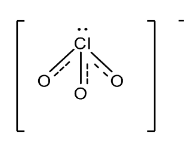
Explain the hybridization of the central atom in $Cl{{O}_{3}}^{-}$.
Answer
576.3k+ views
Hint: The hybridization can be calculated with the number of valence electrons of the central atom, number of monovalent atoms/ groups surrounding the central atom, charge on the cation, and charge on the anion.
Complete step by step answer:
Hybridization is defined as the mixing of the atomic orbitals belonging to the same atom but having slightly different energies so that redistribution of energy takes place between them resulting in the formation of new orbitals of equal energies and identical shapes. The orbitals thus formed are known as hybrid orbitals.
In $Cl{{O}_{3}}^{-}$ ion the central atom is chlorine and it is surrounded by three oxygen atoms. It has one lone pair.
For calculating the number of hybrid orbital or hybridization of central atom we can use the formula:
$X=\frac{1}{2}\left[ \begin{align}
& \{\text{no}\text{. of valence electrons of central atom }\!\!\}\!\!\text{ + }\!\!\{\!\!\text{ no}\text{. of monovalent atoms }\!\!\}\!\!\text{ } \\
& \text{ - }\!\!\{\!\!\text{ charge on cation }\!\!\}\!\!\text{ + }\!\!\{\!\!\text{ charge on the anion }\!\!\}\!\!\text{ } \\
\end{align} \right]$
$X=\frac{1}{2}\left[ VE+MA-c+a \right]$
So, in $Cl{{O}_{3}}^{-}$ the central atom chlorine has 7 valence electrons.
There is no monovalent atom present in $Cl{{O}_{3}}^{-}$ . Oxygen is a divalent atom.
There is no cationic charge on $Cl{{O}_{3}}^{-}$.
The anionic charge on $Cl{{O}_{3}}^{-}$ is 1.
So, by putting all these in the equation, we get
$X=\frac{1}{2}\left[ 7+0-0+1 \right]=\frac{8}{2}=4$
The value of X is 4, therefore, the hybridization is $s{{p}^{3}}$ .
The structure of chlorate ion ($Cl{{O}_{3}}^{-}$) is given below:

Because of $s{{p}^{3}}$ hybridization the structure of chlorate ion ($Cl{{O}_{3}}^{-}$) is predicted to be tetrahedral but the actual structure of chlorate ion is pyramidal. This is because of the presence of one lone pair.
Note: Only monovalent atoms can be considered. For divalent ion, MA = 0. By calculating the hybridization the structure can be predicted, but due lone pair the structure will get changed. So for predicting the shape, lone pairs should be considered.
Complete step by step answer:
Hybridization is defined as the mixing of the atomic orbitals belonging to the same atom but having slightly different energies so that redistribution of energy takes place between them resulting in the formation of new orbitals of equal energies and identical shapes. The orbitals thus formed are known as hybrid orbitals.
In $Cl{{O}_{3}}^{-}$ ion the central atom is chlorine and it is surrounded by three oxygen atoms. It has one lone pair.
For calculating the number of hybrid orbital or hybridization of central atom we can use the formula:
$X=\frac{1}{2}\left[ \begin{align}
& \{\text{no}\text{. of valence electrons of central atom }\!\!\}\!\!\text{ + }\!\!\{\!\!\text{ no}\text{. of monovalent atoms }\!\!\}\!\!\text{ } \\
& \text{ - }\!\!\{\!\!\text{ charge on cation }\!\!\}\!\!\text{ + }\!\!\{\!\!\text{ charge on the anion }\!\!\}\!\!\text{ } \\
\end{align} \right]$
$X=\frac{1}{2}\left[ VE+MA-c+a \right]$
So, in $Cl{{O}_{3}}^{-}$ the central atom chlorine has 7 valence electrons.
There is no monovalent atom present in $Cl{{O}_{3}}^{-}$ . Oxygen is a divalent atom.
There is no cationic charge on $Cl{{O}_{3}}^{-}$.
The anionic charge on $Cl{{O}_{3}}^{-}$ is 1.
So, by putting all these in the equation, we get
$X=\frac{1}{2}\left[ 7+0-0+1 \right]=\frac{8}{2}=4$
The value of X is 4, therefore, the hybridization is $s{{p}^{3}}$ .
The structure of chlorate ion ($Cl{{O}_{3}}^{-}$) is given below:

Because of $s{{p}^{3}}$ hybridization the structure of chlorate ion ($Cl{{O}_{3}}^{-}$) is predicted to be tetrahedral but the actual structure of chlorate ion is pyramidal. This is because of the presence of one lone pair.
Note: Only monovalent atoms can be considered. For divalent ion, MA = 0. By calculating the hybridization the structure can be predicted, but due lone pair the structure will get changed. So for predicting the shape, lone pairs should be considered.
Recently Updated Pages
Master Class 11 Economics: Engaging Questions & Answers for Success

Master Class 11 English: Engaging Questions & Answers for Success

Master Class 11 Social Science: Engaging Questions & Answers for Success

Master Class 11 Biology: Engaging Questions & Answers for Success

Class 11 Question and Answer - Your Ultimate Solutions Guide

Master Class 11 Business Studies: Engaging Questions & Answers for Success

Trending doubts
What is meant by exothermic and endothermic reactions class 11 chemistry CBSE

10 examples of friction in our daily life

One Metric ton is equal to kg A 10000 B 1000 C 100 class 11 physics CBSE

Difference Between Prokaryotic Cells and Eukaryotic Cells

What are Quantum numbers Explain the quantum number class 11 chemistry CBSE

1 Quintal is equal to a 110 kg b 10 kg c 100kg d 1000 class 11 physics CBSE




